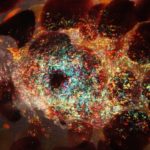News, Squid camouflage may lead to next gen of bio-inspired synthetic materials
Researchers in the lab of UC Santa Barbara professor Daniel Morse have long been interested in the optical properties of color-changing animals, and they are particularly intrigued by the opalescent inshore squid. Also known as the California market squid, these animals have evolved the ability to finely and continuously tune their color and sheen to a degree unrivaled in other creatures. This enables them to communicate, as well as hide in plain sight in the bright and often featureless upper ocean. In previous work, the researchers uncovered that specialized proteins, called reflectins, control reflective pigment cells — iridocytes — which in turn contribute to changing the overall visibility and appearance of the creature. But still a mystery was how the reflectins actually worked. “We wanted now to understand how this remarkable molecular machine works,” said Morse, a Distinguished Emeritus Professor in the Department of Molecular, Cellular and Developmental Biology, and principal author of a paper that appears in the Journal of Biological Chemistry. Understanding this mechanism, he said, would provide insight into the tunable control of emergent properties, which could open the door to the next generation of bio-inspired synthetic materials.
Related posts:
Learn about our two Decals!
 Click here to find out more about our Fall Bioinspired Design Decal and our Spring Bioinspired Design in Action Decal – ALL MAJORS are welcome.
Click here to find out more about our Fall Bioinspired Design Decal and our Spring Bioinspired Design in Action Decal – ALL MAJORS are welcome.Berkeley BioDesign Community
 Click here to learn about the BioD: Bio-Inspired Design @ Berkeley student organization or here to signup for more info.
Click here to learn about the BioD: Bio-Inspired Design @ Berkeley student organization or here to signup for more info.Search
Student Login





I imagine that the neurological circuits underlying these processes are governed by both 2d spacing maps with their brains as…
to reduce the impact of car accidents, it may be possible to study the force diverting physics of cockroaches to…
you see this type of head-bobbing stability in many avian creatures related to pigeons like chickens. the head ability to…
not like they taught horses how to run! this is an example of convergent evolution where both sea creatures and…
The brain functions in a similar way with neuronal connections. our brains are able to utilize the multiplicity of connections…